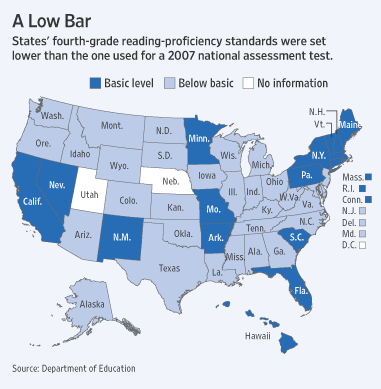Susan Troller, via a kind reader’s email:
Madison’s achievement gap — driven in large part by how well white students perform on the Wisconsin Knowledge and Concepts Exam — is significant compared to other urban districts in the state with high minority populations. White students here perform significantly better on the annual tests than students in Milwaukee, Racine, Kenosha and Beloit and scores for Madison’s black students are somewhat better than in Milwaukee or Racine. But black students’ scores in Madison are lower than Kenosha’s and, among younger students, lower than Beloit’s, too.
The point spread between the scores of Madison’s white and black sophomore students on the WKCE’s 2008 math test was a whopping 50 points: 80 percent of the white students taking the test scored in the advanced and proficient categories while just 30 percent of the black students scored in those categories. It’s a better performance than in Milwaukee, where just 19 percent of black students scored in the advanced and proficient categories, or Racine, where 23 percent did, but it lags behind Kenosha’s 38 percent. None of the scores are worth celebrating.
Adam Gamoran, director of the Wisconsin Education Research Center at the University of Wisconsin-Madison, is a nationally known expert whose work has often explored issues related to the achievement gap. He says racism, overt or inadvertent, may make school feel like a hostile environment for black students, and that it needs to be recognized as a potential factor in the achievement gap.
“It would be naive to say it doesn’t exist, and that it’s not a problem for a certain number of students,” Gamoran says. He cites disproportionate disciplinary actions and high numbers of black students referred to special education, as indicators of potential unequal treatment by race.
Green, who attended Madison’s public schools, says when black students are treated unfairly it’s a powerful disincentive to become engaged, and that contributes to the achievement gap.
“There’s plenty of unequal treatment that happens at school,” says Green who, while in high school at La Follette, wrote a weekly, award-winning column about the achievement gap for the Simpson Street Free Press that helped her land a trip to the White House and a meeting with Laura Bush.
“From the earliest grades, I saw African-American males especially get sent out of the classroom for the very same thing that gets a white student a little slap on the wrist from some teachers,” she says. “It’s definitely a problem.”
It manifests itself in students who check out, she says. “It’s easy to live only in the present, think that you’ve got better things to do than worry about school. I mean, it’s awfully easy to decide there’s nothing more important than hanging out with your friends.”
But Green advocates a doctrine of personal responsibility. She encourages fellow minority students to focus on academic ambitions, starting with good attendance in class and following through with homework. She also counsels students to take challenging courses and find a strong peer group.
“The bottom line, though, is that no one’s going to get you where you’re going except you,” she says
Related: “They’re all rich, white kids and they’ll do just fine” — NOT!.

